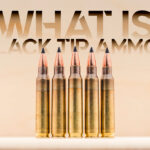
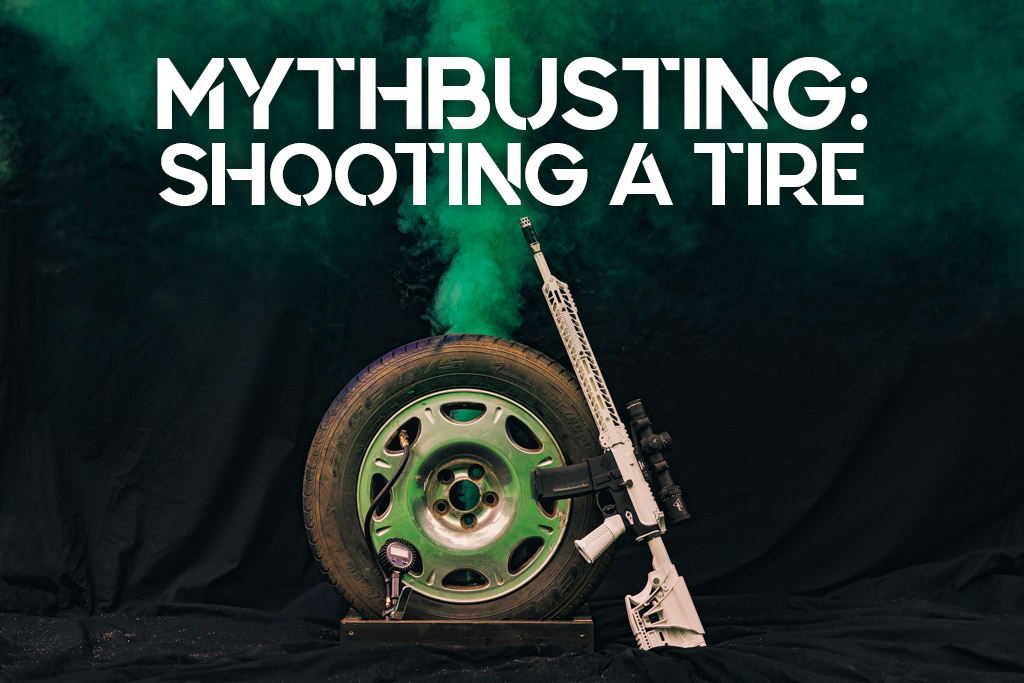
Guest Writer: Kenzie Fitzpatrick
We’ve all seen Hollywood movies where cops or bad guys are shooting tires to end a high-speed chase. Realistic or not, we’ve frequently seen tires shot from the windows of moving cars. Or other unlikely scenarios, like the hero standing in the middle of the road to shoot the tires of an oncoming car. The most realistic, and least exciting plot, is shooting the tires of a parked car, so there’s no chance of it being used to follow someone on screen.
While all of these options may be clever ways to move a storyline, they may not be an efficient way to stop a speeding vehicle in real life. So which calibers out of what guns can actually penetrate a tire? We set out to test this theory and see if we could bust the myths and answer a few questions along the way.
Testing Goals
While we couldn’t shoot at an actual moving vehicle (or stationary one), we did set several testing goals. These goals were to measure the penetration depth, rate of deflation, and effectiveness of each caliber on the tires. Our main goal was to use the data collected to gain a better understanding of what happens when a bullet penetrates a tire.
We did our best to make this myth-busting experience as realistic as possible from the tires we chose to the calibers we shot. The common calibers we chose are all likely to be found in any gun owner’s ammo stash. We also don’t think most civilians or law enforcement are rolling around on any big beefy all-terrain or bulletproof tires (you know, budgets and what not?).
Shooting A Tire: Testing Procedures
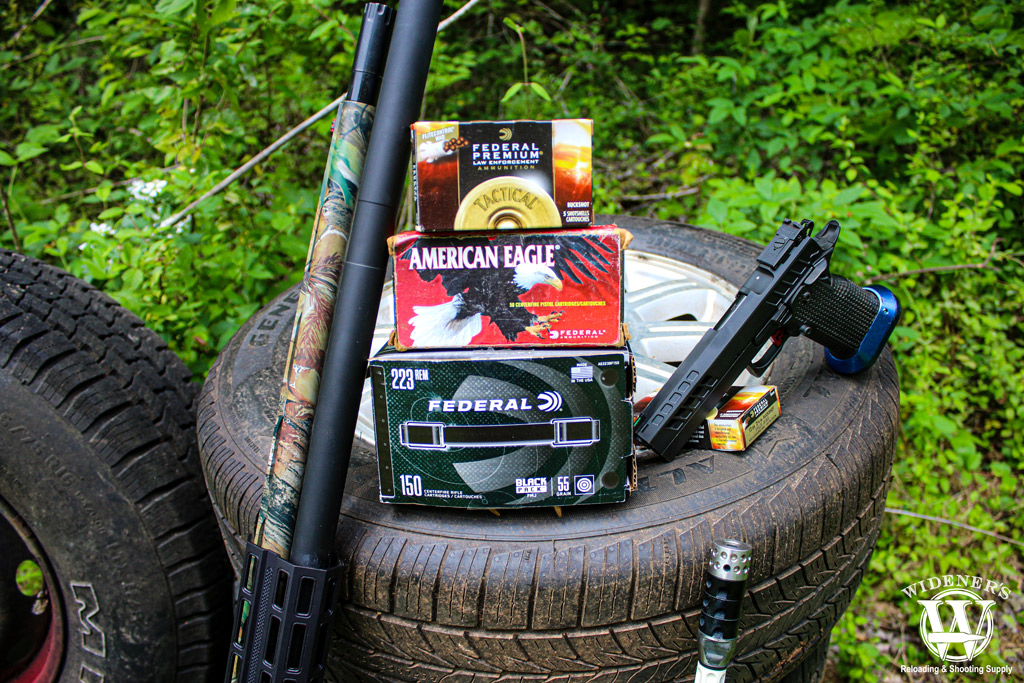
We used Federal brand 9mm, 223 Rem, and 12-Gauge shells in our controlled testing.
For those science types, we tried to create as controlled an environment as possible. We purchased 6 common SUV/car tires to shoot at with a pistol, a rifle, and a shotgun. We ended up with five 225/60 R16 tires, and one random 265/75 R16 tire on rims. All tires were able to hold air when inflated and were held in place on a tire stand.
What about ammo? Most law enforcement officers or criminals aren’t carrying around a 6.5 Creedmoor rifle. It’s rare (if ever) to still see an officer with a .357 magnum revolver on their hip. It’s rarer still to hear reports of any law enforcement agencies using a 10-Gauge shotgun. So instead, we chose the three most common calibers for testing purposes.
Ammunition Used For Our Testing:
- Federal AE 9mm 115gr FMJ
- Federal .223 55gr FMJ
- Federal 12-Gauge, 00 Buck, 8 Pellet, 2-3/4″ Shotgun Shells
Where Do You Shoot A Tire?
We discussed how tires are shot in big box office films and found a common theme. Some shots are fired head-on at the tread of a tire, while others are shot in the sidewalls. For our experiment, each gun was used to shoot two tires – one tire from the side and one tire head-on directly at the treads.
We shot each tire from the same distance, about 15 feet away. We did this for safety and to try and replicate shots made from a car length away in the movies. What wasn’t tested was shooting a moving target while stationary, or also while moving, which we’ll get into as you keep reading.
Testing Measurements
Penetration depth was one of the data points for each caliber. For the sidewalls of the tire, we looked for both the entry and exit holes. We also looked for any shrapnel or lodged bullets and fragments still in the tire. When shooting at the treads of a tire, we were looking for the entry and exit path of the bullet, any wheel/rim damage, and shrapnel.
All of the tires we used started out with 35 pounds per square inch (PSI) inflation. The rate of deflation was an important factor to understand. We recorded which calibers gave the tires a slow leak VS going from 35 PSI to 0 upon impact. That data proved to be valuable in understanding the length of time a tire could continue running after being shot.
So, did the direction of shooting the tire make a difference in the deflation rate? To measure the rate of deflation, we set the tire on a stand and attached a digital tire pressure gauge to it. The gauge was attached to the tire for the pre-shot, during the shot, and post-shot to see what happened.
We had some assumptions about what each caliber would do to the tire, but we wanted to compare the effectiveness of each caliber. This data includes recording damage to the rim, shrapnel, and how easy it would be to hit the tire.
Shooting A Tire: Mythbusted?
Shooting A Tire: 9mm 115gr FMJ

Although the 9mm 115gr FMJ performed well, it was the least effective of the three calibers we tested.
The most common weapon a law enforcement officer or criminal is going to carry is a handgun. A 9mm bullet is definitely an effective caliber to use to take down a tire, but not as fast as we thought it would be. After shooting the sidewall of the tire, we noticed that the entrance hole was no bigger than a hole a nail in the tire would cause. The exit hole was easier to find, but just as tiny. The air leaked at the slowest rate of the three calibers and other than a slight hissing sound from the air escaping, it mostly went unnoticed.
When we shot the next tire at the treads head-on, the same small hole was difficult to find. However, the 9mm FMJ bullet penetrated the rim of the tire and then it flattened against the opposite side of the rim wall, leaving only some shrapnel behind. While the bullet penetrated the tire, the velocity of the bullet slowed down and didn’t have the power to exit the other side.
Measurements
| Caliber/Location | Bullet Weight | Velocity | Deflation (35-0 PSI) | Penetration |
|---|---|---|---|---|
| 9mm (Sidewall) | 115gr | 1180 | 1.756 Minutes | 8″+ |
| 9mm (Tread) | 115gr | 1180 | 3.20 Seconds | 20″ |
Penetration Depth: The full metal jacket 9mm bullet had enough power to enter and exit the 8″+ sidewalls of the tire, but not enough to go completely through the tire and rim when shot through the treads.
Rate Of Deflation: A pistol caliber will do the trick, but not as fast or glamorous as we see on the big screen. The rate of deflation from the sidewall was the slowest recorded at over a minute to reach 0 PSI. Shooting the tire tread was a much more effective solution.
Effectiveness Of Caliber: Just as with concealed carry, one hit to the target is enough to neutralize the threat. Most likely, that car isn’t getting very far in a chase scenario.
Shooting A Tire: .223 55gr FMJ
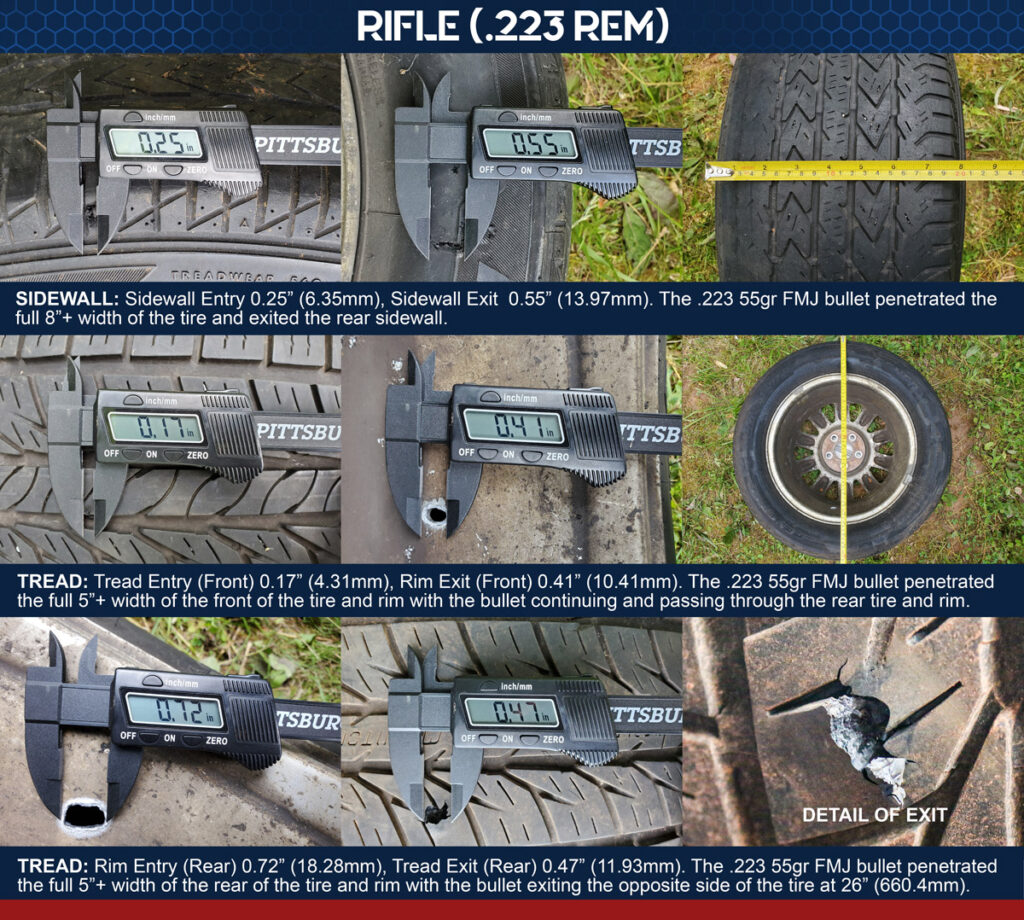
The .223 Rem 55gr FMJ bullet passed through the tire and rim like a hot knife going through butter.
The .223 Rem, 55gr full metal jacket bullet moves quite a bit faster than the 9mm bullet. From the 16″ barrel of an AR-15 rifle, the .223 bullet had a clean entrance and exit through the sidewall of the tire. The trajectory of the bullet changed as it went through the tire leaving a much larger exit hole than entry. Shooting a rifle at a tire is devastating and will quickly deflate a tire as seen in our video.
A rifle will make quick work of a tire when shooting head-on at the treads. While the entry hole was even smaller than the 9mm bullet, the penetration went through the front of the tire, completely through both sides of the circular rim, and out the rear of the tire. The first bullet hole through the rim was much smaller compared to the second as it was leaving the tire. The rear of the tire had a large exit where the bullet took a good size chunk out of the tread.
Measurements
| Caliber/Location | Bullet Weight | Velocity | Deflation (35-0 PSI) | Penetration |
|---|---|---|---|---|
| 223 Rem (Sidewall) | 55gr | 3240 | 17.12 Seconds | 8″+ |
| 223 Rem (Tread) | 55gr | 3240 | 2.15 Seconds | 26″+ |
Penetration Depth: The .223 Rem, 55gr FMJ penetrated completely through the tire from the sidewall angle. It was even more impressive head-on at the treads. It passed through both sides of the tire and rim clearing 26″+ of penetration depth.
Rate Of Deflation: The rate of deflation was the fastest recorded from 35 to 0 PSI when shot from both directions. The damage to the tire and rim from the bullet allowed daylight to be visible through the openings.
Effectiveness Of Caliber: We can definitely conclude that a tire is absolutely no match for a .223 Rem bullet. Given the penetration depth we recorded, it’s likely the bullet could do additional damage to the vehicle after passing through the tire.
Shooting A Tire: 12 Gauge 8 Pellet Shotgun Shells
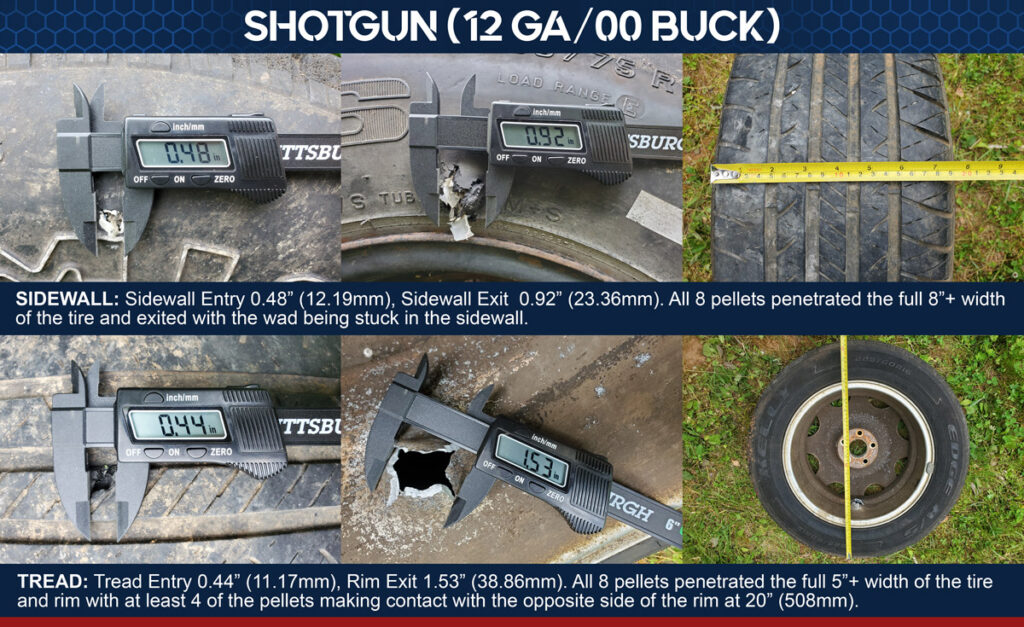
The 12-Gauge, 00 Buck, 8-Pellet 2-3/4″ shell punched a hole right through the tire and rim.
We were not expecting what happened with our shotgun load to take place during testing. Shotguns may often be viewed as a last resort, but we can confirm they make for a great defensive gun. The damage from a 12-Gauge 8-Pellet 2-3/4″ shell VS a tire was devastating.
Shooting the sidewall of the tire completely blew our minds (and the internals of the tire out). Upon impact of the sidewall, the shotgun hull went with the trajectory of the beads and lodged into the front of the sidewall and out the back. The rest of the spread of the shotgun beads ripped holes through our backdrop curtain.
We saw a similar trend when it came time to shoot the treads of the tire. The entry hole was deceiving in size, looking like barely any penetration took place. Given the spread and number of pellets, it was much smaller than we expected. The exit hole, however, from the shot going through the rim was the largest recorded (at over 1.5″).
We had immediate deflation and shotgun bead shrapnel was everywhere. While the beads did not penetrate through the other side of the rim, the beads did hit and flatten against the metal rim and land all around our backdrop cloth.
Measurements
| Caliber/Location | Ammo Type | Velocity | Deflation (35-0 PSI) | Penetration |
|---|---|---|---|---|
| 12 Gauge (Sidewall) | 8 Pellet – 00 Buck | 1145 | 27.17 Seconds | 8″+ |
| 12 Gauge (Tread) | 8 Pellet – 00 Buck | 1145 | 2.55 Seconds | 20″ |
Penetration Depth: A shotgun is highly effective at penetrating through the sidewall of a tire, but not as effective from front to rear with a head-on tread shot. Either way, the damage to the tire was catastrophic.
Rate Of Deflation: Just the opposite of a car, a shotgun can go from 60 to 0 real quick. In our test, it finished in second place behind the .223 Rem dropping the tire from 35 to 0 PSI in seconds.
Effectiveness Of Caliber: Shotguns tend to be viewed as the underdog when compared to pistols or rifles. However, if you like blowing holes in things, we have good news. The effectiveness of a 12 Gauge, 00 Buck, 8-Shot shell is spot on for shooting a tire.
Real-Life VS Hollywood
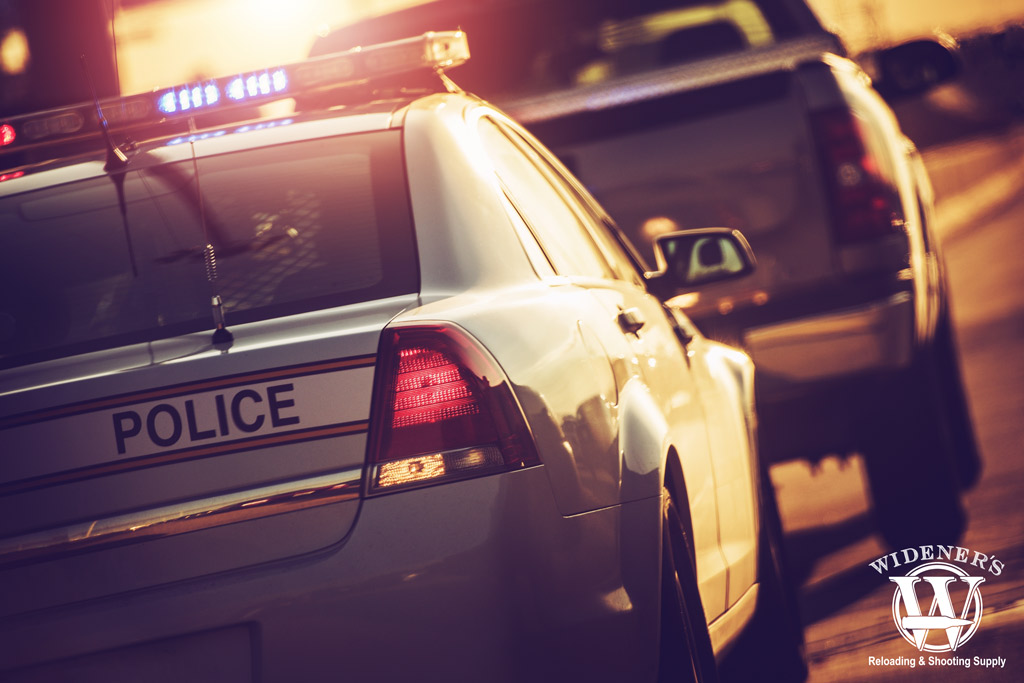
Unless there’s a direct threat, it’s unlikely the police would need to shoot out a suspect’s tires in a car chase.
There are a few things we felt the need to point out when it comes to Hollywood VS real-life defensive situations. How often do you practice shooting at a moving vehicle while in another moving vehicle? How about offhand rifle shots? Unsupported adrenaline dump pistol shots? You’ll also need to know ammunition specifics, like velocity, to know where to aim with a rifle or pistol at different distances.
Ever patterned your shotgun to know what chokes and what ammunition does what through the barrel? We definitely couldn’t replicate these conditions, but we know a little something about shooting under stress and on the move. Even with some of the best shooting guns, it’s not as easy as it looks to make one solid hit exactly where you wanted it to go.
Ammunition types are an important factor when shooting at tires or any threat, especially for shotguns. Shotguns pattern differently in different length barrels. These patterns can vary with different ammunition, and with different chokes. Buckshot and birdshot will spread differently as well and at different rates. If a target is far away and you have birdshot with a spreader choke in, the projectiles in the shell may just “pepper” the target rather than penetrate it.
What About Police Departments?
Police are generally trained not to shoot out car tires during a pursuit as the first line of defense. Not because the bullets will bounce back/off, but because it’s dangerous to fire a gun on public roads because of traffic, residences, and businesses. Hitting innocent bystanders would be a likely probability with ricochets or over-penetration.
Similarly, if police are firing their guns, they usually have the authorization to use deadly force. In those cases, they aren’t necessarily going to be aiming for tires. If the threat is real, they’re looking to neutralize the threat, AKA, the bad guy, and not just stop their vehicle.
All things considered for real-life, a well-executed pit maneuver or spike strips would be much safer at stopping a vehicle than shooting at it.
Bullet-Resistant/Proof & Run-Flat Tires
We couldn’t get our hands on any bulletproof or run-flat tires for this test, but they are available. Depending on the LEO agency’s budget, their fleet vehicles may be equipped with runflat tires. Runflats allow a vehicle to travel up to 60 miles (on average) after the tire has been deflated depending on the terrain. Bulletproof or resistant tires can be self-sealing or have a system built into them to continuously pump air into the tires.
We couldn’t forget to mention the bulletproof tires on an ArmorMax Tesla Model S. We can only hypothesize as they’ve shown in the video, that when these tires have been shot, the tires would blow out and all the rubber would come off so you’d only be driving on the wheel. The concept of these bulletproof tires is to keep the rubber attached to the wheel long enough to flee from the chase.
Hypothetical Scenarios
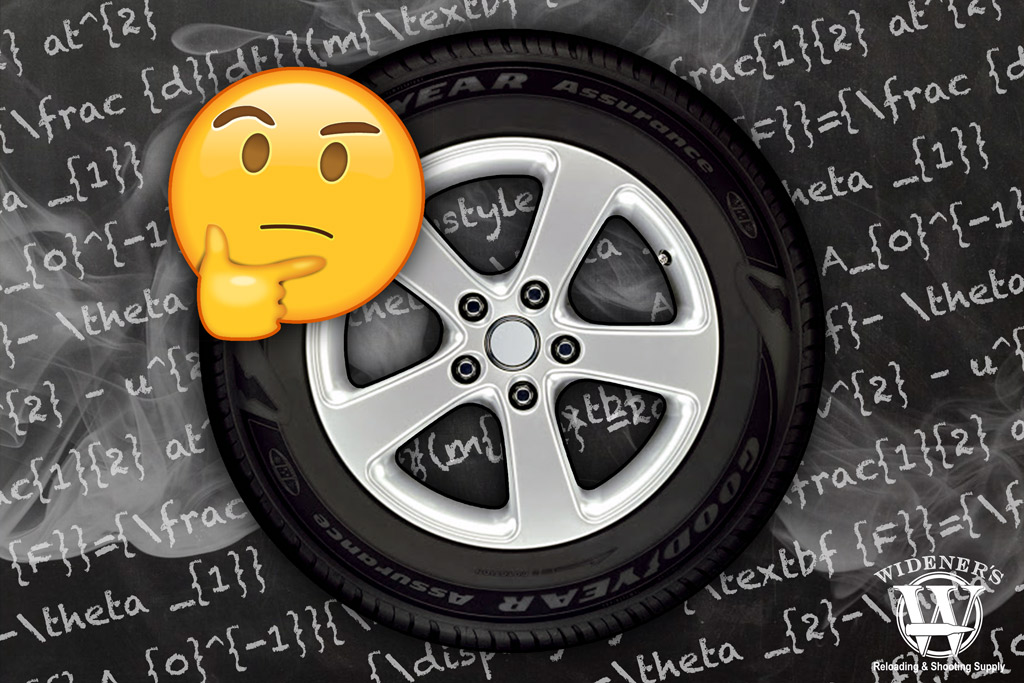
Ok, but what about… We wondered the same thing, take a look at the hypothetical questions below.
Although we gathered some valuable data, our field testing was limited to the materials we had on hand. These limitations left the door open to further discussion about the possibilities of several hypothetical situations. Since these scenarios have real-world implications, we decided to bring in an expert. We reached out to Phillip Chesser, an engineer at Oak Ridge National Laboratory, with a Master of Science in mechanical engineering, to address some of these concerns. We’ll let him take the wheel from here.
Scenario #1: Weight On Tires
We wanted to know if the weight of a vehicle on the tires could increase the rate (speed) of deflation after the bullet punctures the tire. We were able to confirm that in fact, it would. This is primarily due to the vehicle weight driving a volume change, causing the internal volume of the tire to get smaller as it deflates.
Chesser points out, “There are differential equations that can be used to solve this problem, but they would be highly sensitive to many real-world conditions that can be hard to predict.”
However, to make this more realistic, if the same rate of deflation is assumed from the collected data, the time until the rims touch the ground can be calculated. This gives a more realistic failure mode than simply the time until 0 (or near 0) pressure. The average car weight is 4,094 lbs, so each tire carries 1024 lbs. With tire dimensions of 16” inner diameter, 26.6” outer diameter, and 8.9” width, the rim will touch the ground at 5.6 psi. This gives us the following times until the rim touches the ground.
| Caliber/Location | Time Until Rim Touches The Ground |
|---|---|
| 9mm (Sidewall) | 94.5 Seconds |
| 9mm (Tread) | 2.6 Seconds |
| 223 Rem (Sidewall) | 14.9 Seconds |
| 223 Rem (Tread) | 1.4 Seconds |
| 12 Gauge (Sidewall) | 24.3 Seconds |
| 12 Gauge (Tread) | 18.1 Seconds |
Scenario #2: Vehicle Speed
Another question that concerned us was the vehicle’s rate of speed affecting the tire’s rate of deflation. Does driving faster cause the tire to go flat more quickly after it’s been shot? Phillip points out that again, this is a hard question since there are many unknown factors, such as road temperature and roughness, and heating of the tires due to driving. However, it is very unlikely that speed would have a significant effect.
Chesser also indicates that in the scenario of the tread being shot, as the tire rotates, for a brief portion of the rotation the hole will be covered by the ground slowing the air leak briefly. Yet, it will likely not form a good seal, and not significantly affect overall time to deflation. It is also possible the impact of bumps, rocks, etc. on the tire would cause brief periods of increased deflation. Again, this is very hard to predict or calculate, and any attempt to do so would likely not improve the accuracy of the data already collected in the test.
Scenario #3: Rotation Displacement
This question might be more in the fictional category, but it’s fun to consider. Could the rotation of a tire at increased MPH interfere with a bullet’s flight path, ultimately affecting the penetrating capabilities of the bullet? In theory, could a tire possibly spin fast enough to displace the trajectory of a bullet? It certainly sounds like something you’d see in a Hollywood blockbuster.
“Due to the high velocity of the bullet relative to the tire, the tire would look nearly stationary to the bullet.” -Phillip Chesser, Oak Ridge National Laboratory Engineer
Chesser tells us right off the bat, this isn’t a realistic possibility. For example, if we look at the 9mm, the lowest-performing caliber from the test. The 9mm 115gr bullet travels at 1180 FPS or 805 mph. The fastest-moving part of a tire of a car going 80 mph is 160 mph. The bullet is traveling at over 5X times the speed of the tire. If the bullet is .5” long the tire will move between 0.10” and 0.20” during the penetration. It is unlikely that this would cause a significant change in penetration, especially with the high elasticity of the rubber.
Overall, Chesser concludes, “While the test scenarios are not fully realistic, it is hard to compensate for the real-world effects. The data as it was taken is likely the best indication, with the tests that were done, as to what deflation time would be in a real-world scenario. Attempts to compensate for additional effects would likely not give a more accurate estimate.”
Myths VS Facts
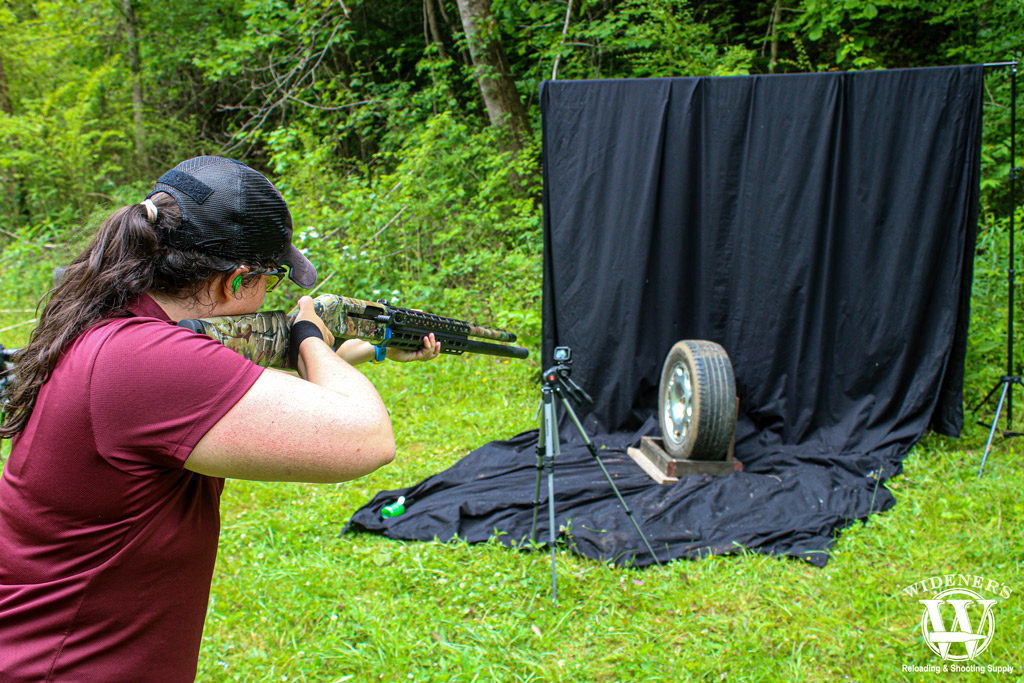
Myth-busted? Not exactly, tires are no match for good shot placement with common-caliber bullets.
So what did we learn? We learned that any of these common-caliber bullets can take down a tire. Depending on where you shoot the tire, it may deflate in an instant or be a slow leak. Either way, you aren’t going to get very far if a bullet penetrates your tire. Hollywood may overdo it with theatrics and a disregard for public safety (not to mention the legal implications), but a standard car or SUV tire is no match for a bullet.


